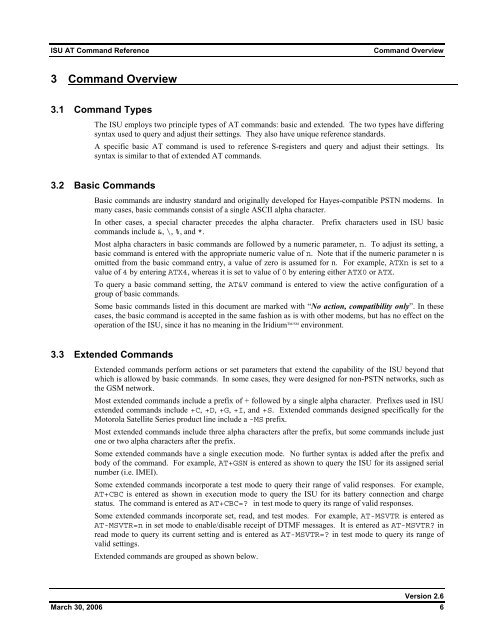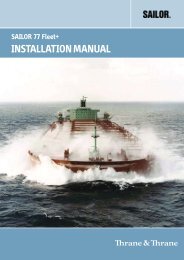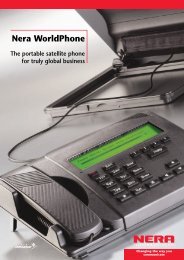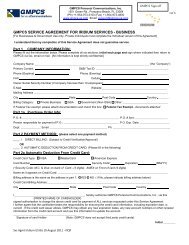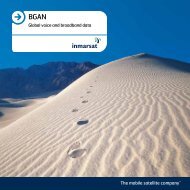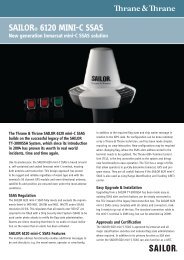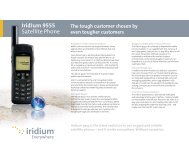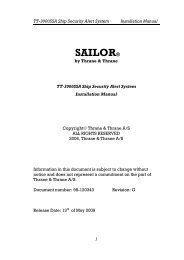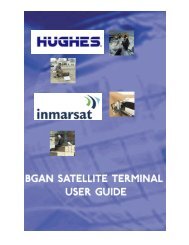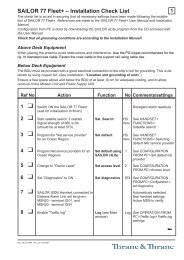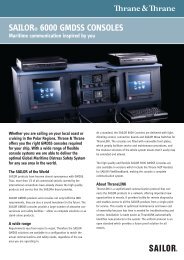ISU AT Command Reference
ISU AT Command Reference
ISU AT Command Reference
You also want an ePaper? Increase the reach of your titles
YUMPU automatically turns print PDFs into web optimized ePapers that Google loves.
<strong>ISU</strong> <strong>AT</strong> <strong>Command</strong> <strong>Reference</strong><strong>Command</strong> Overview3 <strong>Command</strong> Overview3.1 <strong>Command</strong> TypesThe <strong>ISU</strong> employs two principle types of <strong>AT</strong> commands: basic and extended. The two types have differingsyntax used to query and adjust their settings. They also have unique reference standards.A specific basic <strong>AT</strong> command is used to reference S-registers and query and adjust their settings. Itssyntax is similar to that of extended <strong>AT</strong> commands.3.2 Basic <strong>Command</strong>sBasic commands are industry standard and originally developed for Hayes-compatible PSTN modems. Inmany cases, basic commands consist of a single ASCII alpha character.In other cases, a special character precedes the alpha character. Prefix characters used in <strong>ISU</strong> basiccommands include &, \, %, and *.Most alpha characters in basic commands are followed by a numeric parameter, n. To adjust its setting, abasic command is entered with the appropriate numeric value of n. Note that if the numeric parameter n isomitted from the basic command entry, a value of zero is assumed for n. For example, <strong>AT</strong>Xn is set to avalue of 4 by entering <strong>AT</strong>X4, whereas it is set to value of 0 by entering either <strong>AT</strong>X0 or <strong>AT</strong>X.To query a basic command setting, the <strong>AT</strong>&V command is entered to view the active configuration of agroup of basic commands.Some basic commands listed in this document are marked with “No action, compatibility only”. In thesecases, the basic command is accepted in the same fashion as is with other modems, but has no effect on theoperation of the <strong>ISU</strong>, since it has no meaning in the Iridium TM/SM environment.3.3 Extended <strong>Command</strong>sExtended commands perform actions or set parameters that extend the capability of the <strong>ISU</strong> beyond thatwhich is allowed by basic commands. In some cases, they were designed for non-PSTN networks, such asthe GSM network.Most extended commands include a prefix of + followed by a single alpha character. Prefixes used in <strong>ISU</strong>extended commands include +C, +D, +G, +I, and +S. Extended commands designed specifically for theMotorola Satellite Series product line include a -MS prefix.Most extended commands include three alpha characters after the prefix, but some commands include justone or two alpha characters after the prefix.Some extended commands have a single execution mode. No further syntax is added after the prefix andbody of the command. For example, <strong>AT</strong>+GSN is entered as shown to query the <strong>ISU</strong> for its assigned serialnumber (i.e. IMEI).Some extended commands incorporate a test mode to query their range of valid responses. For example,<strong>AT</strong>+CBC is entered as shown in execution mode to query the <strong>ISU</strong> for its battery connection and chargestatus. The command is entered as <strong>AT</strong>+CBC=? in test mode to query its range of valid responses.Some extended commands incorporate set, read, and test modes. For example, <strong>AT</strong>-MSVTR is entered as<strong>AT</strong>-MSVTR=n in set mode to enable/disable receipt of DTMF messages. It is entered as <strong>AT</strong>-MSVTR? inread mode to query its current setting and is entered as <strong>AT</strong>-MSVTR=? in test mode to query its range ofvalid settings.Extended commands are grouped as shown below.Version 2.6March 30, 2006 6


